| |
Transverberation |
| |
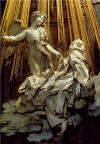 Transverberation
is a spiritual wounding of the heart, as a reward by God for loving him.
Several saints experienced it. Some few names: Teresa of Avila, Therese
of Lisieux, Veronica Giuliani, Marguerite Marie Alacoque, Gerard Majella,
Joseph of Cupertino, Francis de Sales, Philip Neri, Jane Francis de
Chantal, Lutgarde, Charles of Sezze. Transverberation
is a spiritual wounding of the heart, as a reward by God for loving him.
Several saints experienced it. Some few names: Teresa of Avila, Therese
of Lisieux, Veronica Giuliani, Marguerite Marie Alacoque, Gerard Majella,
Joseph of Cupertino, Francis de Sales, Philip Neri, Jane Francis de
Chantal, Lutgarde, Charles of Sezze.
August 5, 1918 Padre Pio had the Transverberation of the heart.
He reported under obedience:
"I was hearing the confessions of the boys, when a Celestial
Being holding a steel sword with a sharp flaming point, hurled it into my soul
with all his might. All done in a split of a second everything in my inside was
lashed by fire and steel. From that moment on I feel an open wound which causes
me to suffer continual agony." |
| |
|
| |
Stigmatization |
| |
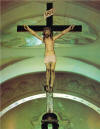 Padre Pio received the visible permanent
stigmata wounds on September 20, 1918, while praying at this Crucifix,
in the choir of the church of the convent, after having celebrated Mass
in the morning. He was 31 years old. Padre Pio received the visible permanent
stigmata wounds on September 20, 1918, while praying at this Crucifix,
in the choir of the church of the convent, after having celebrated Mass
in the morning. He was 31 years old. |
| |
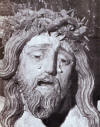 Padre Pio reported under obedience: Padre Pio reported under obedience:
"Suddenly I was
wrapped in a sea of blazing light.
In that light I saw
Jesus. He was very beautiful.
From his wounds came rays
of very bright white light that penetrated my hands, my feet, my
side.
They were like blades of fire that penetrated my skin
piercing, cutting, breaking.
I felt that I would die. The pain was immense." |
| |
 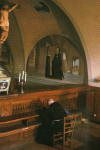 This is the location were Padre Pio received the
stigmata wounds. Over the years he continue to pray in the same spot. This is the location were Padre Pio received the
stigmata wounds. Over the years he continue to pray in the same spot. |
| |
Scourging |
| |
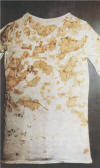 Padre Pio reported under obedience to his superior
that at least once per week he suffered the scourging. Padre Pio reported under obedience to his superior
that at least once per week he suffered the scourging.
This Padre Pio's undershirt, presenting the bloody signs of the scourging,
is preserved in the Capuchin convent of the Holy family in Pietrelcina.
Padre Pio reported in writing:
"I suffer the scourging from the beginning to
the end of the Mass, but more intensely after the Consecration." |
| |

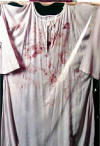 Padre Pio's undershirt stained with blood. Padre Pio's undershirt stained with blood. |
| |
The Way of the Cross |
| |
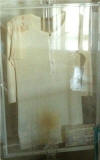 This undershirt of Padre
Pio is preserved in Plexiglas frame in Padre Pio's original cell #5 in
San Giovanni Rotondo. Bloody marks are clearly visible over the
right shoulder. Fra' Modestino refers to this undershirt. At the bottom
right there is the certificate of authenticity. Padre Pio
confided to brother Modestino Fucci, that his greatest pains occurred
when he changed his undershirt. Brother Modestino was the
doorkeeper at Padre Pio’s friary. This undershirt of Padre
Pio is preserved in Plexiglas frame in Padre Pio's original cell #5 in
San Giovanni Rotondo. Bloody marks are clearly visible over the
right shoulder. Fra' Modestino refers to this undershirt. At the bottom
right there is the certificate of authenticity. Padre Pio
confided to brother Modestino Fucci, that his greatest pains occurred
when he changed his undershirt. Brother Modestino was the
doorkeeper at Padre Pio’s friary.
On February 4, 1971 Modestino was assigned the task of taking an
inventory of all the items in the deceased Padre’s cell. The same day he
discovered that one of Padre Pio’s undershirts bore a circle of
bloodstains in the area of the right shoulder. On that evening
asked Padre Pio in prayer to enlighten him about the meaning of the
bloodstained undershirt. He awakened at 1:00 AM with a terrible,
excruciating pain in his shoulder, as if he had been sliced with a knife
up to the shoulder bone. He felt that he would die from the pain if it
continued, but it lasted only a short time. Then the room became filled
with perfume of flowers – the sign of Padre Pio’s presence –
and he heard a voice saying
"Cosi
ho sofferto io!" (This is what I
have suffered!")
|
| |
|
| 1918 |
 Padre Pio was alone in the choir when he received
the wounds. He felt embarrassment, and tried to hid them the best he
could. The father superior suspected something after few days because of
the stains of blood noted here and there. He confronted Padre Pio, and
under obedience got the truth. Padre Pio was alone in the choir when he received
the wounds. He felt embarrassment, and tried to hid them the best he
could. The father superior suspected something after few days because of
the stains of blood noted here and there. He confronted Padre Pio, and
under obedience got the truth. |
| |
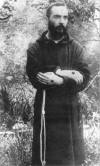  The father superior immediately called the doctor
in town for an evaluation and advice. The superior provincial was
notified, and he informed the superior general in Rome. The superior
general reported
what was happening to the Vatican authorities. Several medical doctors
and ecclesiastical prelates were sent to the convent to investigate the
situation. The father superior immediately called the doctor
in town for an evaluation and advice. The superior provincial was
notified, and he informed the superior general in Rome. The superior
general reported
what was happening to the Vatican authorities. Several medical doctors
and ecclesiastical prelates were sent to the convent to investigate the
situation.
Padre Pio was ordered to answer every question and
show the wounds to the investigators. A friar took some few pictures.
All this was very hard on Padre Pio, but he showed extreme patience and
understanding. The wounds were very painful, day and night, and he tried
to find ways to prevent the blood from dripping everywhere. |
| |
_small.jpg) 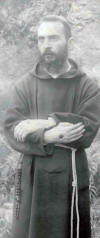  Padre
Pio tried to cover the hands the best he could when
he said Mass. But the faithful noted that something was different and
they noted the wounds, and by word of mouth the news spread, and the
crowds started coming well before the investigators did. Padre
Pio tried to cover the hands the best he could when
he said Mass. But the faithful noted that something was different and
they noted the wounds, and by word of mouth the news spread, and the
crowds started coming well before the investigators did.
"I have asked Jesus to take away this signs
that cause me so much embarrassment. His answer has been: you will
bear them for fifty years."
"I want to suffer, but in secret."
"I desire nothing else than to love and
suffer"
"My sufferings are pleasing."
|
| |
 Padre Pio had
the picture without gloves and other few pictures taken under
obedience by another friar, Padre Placido Bux da San Marco in Lamis. Padre Pio had
the picture without gloves and other few pictures taken under
obedience by another friar, Padre Placido Bux da San Marco in Lamis. |
| |
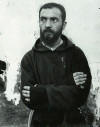 
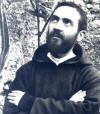 Young
Padre Pio. Young
Padre Pio. |
| |
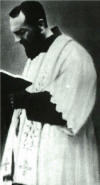
 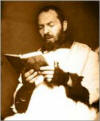 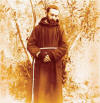 He started covering the hands with some sort of half gloves.
He started covering the hands with some sort of half gloves.
He removed
them only during Mass, and put them back while still at the altar.
|
| |
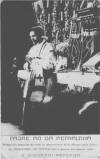 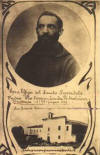 The
news about Padre Pio spread steadily beyond the Gargano and people
started coming from all over. The
news about Padre Pio spread steadily beyond the Gargano and people
started coming from all over.
Souvenir cards with his image popped up.
The card on the left says: "Padre Pio da
Pietralcina. Photograph taken during the celebration of the Mass in the
church of the convent of the capuchins on June 24, 1919. San Giovanni
Rotondo."
The card at the center says: "True effigy of the holy priest Padre Pio
Capuchin from Pietralcina. Picture taken on June 27, 1919 |
| |

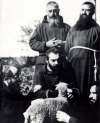 Padre Pio intensified his spiritual life with the
new situation he was in, and also tried to help the faithful, and to be
of least possible burden to the friary.
Padre Pio intensified his spiritual life with the
new situation he was in, and also tried to help the faithful, and to be
of least possible burden to the friary. |
| |
 The newspapers took notice, and soon sent their
journalists mingled through the visitors. The newspapers took notice, and soon sent their
journalists mingled through the visitors. |
| |
 On May 9, 1919 the “Il Giornale d’Italia” was
the first newspaper to report about Padre Pio. On May 9, 1919 the “Il Giornale d’Italia” was
the first newspaper to report about Padre Pio.
On June 1, 1919 “Il Tempo” run a title “Il
miracolo di un Santo” describing he instantaneous healing of a soldier
by Padre Pio.
|
| |
 On June 3, 1919 the same paper “Il Tempo”
titles “I miracoli di Padre Pio a San Giovanni Rotondo”, reports some
prodigies attributed to the friar. Also reports that “at times his body
reaches temperatures of 50 C (F 122) as it has been observed with bath
thermometers)”. On June 3, 1919 the same paper “Il Tempo”
titles “I miracoli di Padre Pio a San Giovanni Rotondo”, reports some
prodigies attributed to the friar. Also reports that “at times his body
reaches temperatures of 50 C (F 122) as it has been observed with bath
thermometers)”. |
| |
 The first full page newspaper article about Padre Pio was published on IL
MATTINO of Naples on June 20, 1919:
The first full page newspaper article about Padre Pio was published on IL
MATTINO of Naples on June 20, 1919:
"Padre Pio, il ‘santo’ di San Giovanni Rotondo,
opera un miracolo sulla persona del Cancelliere del paese. Presente un
nostro inviato.' ('Padre Pio, 'the saint' of San Giovanni Rotondo,
performs a miracle on the local courthouses chancellor. Our envoy was
present.')
|
| |
 The journalist Renato Trevisani reported that Padre
Pio saw the 35 years old Pasquale Di Chiara walking painfully with two
canes. Padre Pio :
?"Throw away those canes."
'How could I?
I will fall to the ground.'
"Throw away those canes" Padre Pio insisted. Pasquale let the canes go while trying to reach for a
support. But there was no need. He was standing normally.
"Man of little faith. Go and walk." Renato Trevisani concluded that several people were
present, and all of them clapped their hands in admiration. The journalist Renato Trevisani reported that Padre
Pio saw the 35 years old Pasquale Di Chiara walking painfully with two
canes. Padre Pio :
?"Throw away those canes."
'How could I?
I will fall to the ground.'
"Throw away those canes" Padre Pio insisted. Pasquale let the canes go while trying to reach for a
support. But there was no need. He was standing normally.
"Man of little faith. Go and walk." Renato Trevisani concluded that several people were
present, and all of them clapped their hands in admiration. |
| |
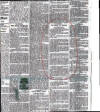 On June 19, 1920 the “Daily Mail” reports
“extraordinary events happening daily in San Giovanni Rotondo”, and
describes how the wounds had been investigated by the doctors and
prelates“. On June 19, 1920 the “Daily Mail” reports
“extraordinary events happening daily in San Giovanni Rotondo”, and
describes how the wounds had been investigated by the doctors and
prelates“.
On October 27, 1923 the Belgian newspaper “Le Soir” describes the wounds, the examinations, the prodigies and the
“very high fevers of 48-50C “(118-122 F).
Since 1919 innumerable articles about Padre
Pio have been written in most every language in the papers around the
world. |
| |
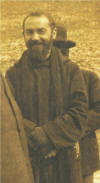 With all the action going on around him Padre Pio
did not lose his joyful ways. He
continued and intensified his ministry, with the Mass lasting close to
three hours, confessing twelve to fifteen hours per day, answering
the correspondence, giving solid spiritual direction, and with three or
four hours left for sleep. With all the action going on around him Padre Pio
did not lose his joyful ways. He
continued and intensified his ministry, with the Mass lasting close to
three hours, confessing twelve to fifteen hours per day, answering
the correspondence, giving solid spiritual direction, and with three or
four hours left for sleep. |
| |
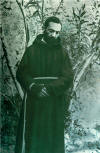 Thing seemed to go well for Padre Pio's ministry,
But soon they changed dramatically. Thing seemed to go well for Padre Pio's ministry,
But soon they changed dramatically.
On June 22, 1922 Padre Antonio da San Giovanni in Persiceto,
General Superior of the Capuchin Order, received a document signed by the Secretary of the Supreme Congregation of the Holy
Office:
'The most Eminent General Inquisitors Cardinals deliberated on
May 10, 1922, regarding Padre Pio da Pietrelcina... He will celebrate Mass in private. He will not bless the
people. He will not show to anybody the so called stigmata. He will stop immediately any communication with Padre
Benedetto, his spiritual director. To best execute the above orders Padre Pio will be
immediately transferred to a convent preferably in Northern Italy. Padre Pio will no more answer letters. Whishing all the best, Cardinal Rafael Merry Del Val." |
| |
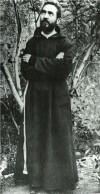 On May 31, 1923 the Holy Office (formerly Tribunal
of Inquisition) declares: "The Supreme
Congregation of the Holy Office, responsible for upholding the faith and defending morals, held an inquiry on the phenomena
attributed to Padre
Pio of Pietrelcina, a member Friar Minor of the Capuchins at the Monastery of San
Giovanni Rotondo in the Diocese of Foggia, and declares that: it cannot confirm
from this inquiry any basis for the supernatural character for this phenomena (" ...non constare de eorundem factorum supernaturalitate...") and exhorts the faithful to confirm their practices to this declaration." On May 31, 1923 the Holy Office (formerly Tribunal
of Inquisition) declares: "The Supreme
Congregation of the Holy Office, responsible for upholding the faith and defending morals, held an inquiry on the phenomena
attributed to Padre
Pio of Pietrelcina, a member Friar Minor of the Capuchins at the Monastery of San
Giovanni Rotondo in the Diocese of Foggia, and declares that: it cannot confirm
from this inquiry any basis for the supernatural character for this phenomena (" ...non constare de eorundem factorum supernaturalitate...") and exhorts the faithful to confirm their practices to this declaration." |
| |
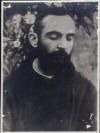 On June 8, 1923. Sant'Uffizio asks for Padre Pio
to be transferred to another convent, in Northern Italy or abroad. Also
orders that his Mass be celebrated in private and nobody can assist to
it. On June 8, 1923. Sant'Uffizio asks for Padre Pio
to be transferred to another convent, in Northern Italy or abroad. Also
orders that his Mass be celebrated in private and nobody can assist to
it.
On August 8, 1923 Padre Pio is
notified of the order to be transferred in another convent.
"As a devout son of the holy obedience, and for
what depends on me, I will obey without opening mouth."
|
| |
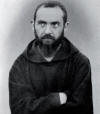 On
August 12, 1923 in a letter to Francesco Morcaldi,
Padre Pio states: "The will of my superiors is the will of God. I only wish that
my bones will rest in a quiet corner of this land." On
August 12, 1923 in a letter to Francesco Morcaldi,
Padre Pio states: "The will of my superiors is the will of God. I only wish that
my bones will rest in a quiet corner of this land."
At this point a popular revolt takes place,
and the police reports that the transfer order cannot be
implemented without "spilling of blood" (spargimento di sangue).
On September 2, 1923 the order of transfer is revoked 'donec
aliter' (until new disposition is given). |
| |
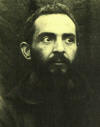 On
May 13, 1931. A decree of Sant'Uffizio prohibits Padre Pio from celebrating Mass in public.
Padre Pio: "I will have less work and more merits." On
May 13, 1931. A decree of Sant'Uffizio prohibits Padre Pio from celebrating Mass in public.
Padre Pio: "I will have less work and more merits."
Padre Pio:
"I want to live and die in the (Roman
Catholic) Church." "The Church is always a mother even when it
strikes." |
| |
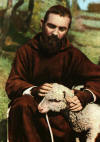 Padre Pio: Padre Pio:
"Only the Catholic Church possesses Jesus in
the Blessed Sacrament."
"Other Christian religions were founded by
different men, but the Catholic religion was founded directly by Jesus
Christ." |
| |
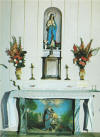 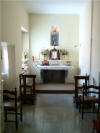  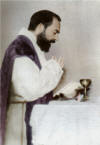 Padre Pio celebrating Mass alone in the internal
chapel of the convent. Padre Pio celebrating Mass alone in the internal
chapel of the convent.
On July 15 1933, the restrictions were
lifted, and Padre Pio resumed Mass in public.
The removal came in the form of and
Indult (special concession) from Cardinal Donato Sbarretti, secretary of the
Holy Office,"in consideration that in this year
1933 there is the celebration of the extraordinary Holy Year of the Redemption".
With the removal of the restrictions for Padre Pio started a long period
of intense apostolate. |
 On September 4, 1916 Padre Pio went
from Foggia for a supposedly brief stay in
the convent of San Giovanni Rotondo.
On September 4, 1916 Padre Pio went
from Foggia for a supposedly brief stay in
the convent of San Giovanni Rotondo. During his lifetime Padre Pio lived in 11
convents. In San Giovanni Rotondo he had the last and longest stay.
During his lifetime Padre Pio lived in 11
convents. In San Giovanni Rotondo he had the last and longest stay.











_small.jpg)



























